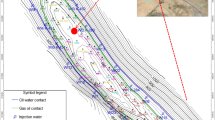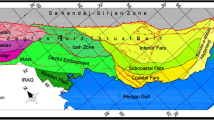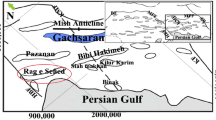Abstract
Historically, in Iran, the borehole imaging tools are acquired to locate major structural features, such as faults, fractures, and sedimentary environment interpretation. The well GS-314 was drilled to evaluate the Asmari formation. It was drilled with an 8.5-in, vertical hole. To get a better understanding of reservoir characteristics of the Asmari formation on the Gachsaran field, to fullbore formation microimager (FMI), repeat formation tester (RFT) and a full set of open hole logs are acquired. The main objective of running FMI was to determine fracture characteristics and locate high porous layers/streaks so that points for RFT survey could be chosen for better results. In this study, it indicated a possible sealing/non-permeable fault in the Asmari reservoir in GS-314 of the Gachsaran field. The RFT pressure data indicated a change of 100 psi in the oil gradients across the fault, indicating possible reservoir compartmentalization in the area around well GS-314. The FMI images indicated a dense layer of 1 m thickness with a dip very different from the bedding around 2173.6 m in the Asmari reservoir. It was interpreted as a sealing fault based on the dense appearance of its plane. In this work, we will show you that how by using a combination of FMI and RFT can interpret a sealing fault in one of the Iranian naturally fractured oil fields.

























Similar content being viewed by others
References
Alavi M (2004) Regional stratigraphy of the Zagros fold-thrust belt of Iran. Am J Sci 304:1–20
Costain JK, Çoruh C (1989) Tectonic setting of Triassic half-grabens in the Appalachians. Seismic data acquisition, processing, and results. AAPG Mem 46:155–174
Daungkaew S, Fujisawa G, Chokthanyawat S, Comrie-Smith N, Thaitong T (2012) Is there a better way to determine the viscosity in waxy crudes? SPE Asia Pacific Oil and Gas Conference and Exhibition 2012: providing a bright future, APOGCE 2012
Motiei H (1993) Stratigraphy of Zagros in Hushmandzadeh. Treatise on the Geology of Iran: Tehran, Geological Survey of Iran, 536 p
Motiei H (1995) Petroleum geology of Zagros. Geological survey of Iran with cooperation of Deputy Ministry of project and planning, no. 25
Movahed Z, Junin R, Safarkhanlou Z, Akbar M (2014) Formation evaluation in Dezful embayment of Iran using oil-based-mud imaging techniques. J Pet Sci Eng 121(2014):23–37
Rezaie MR (2006) The book of petroleum geology, alavi propagation; p 472
Schlumberger (2009). Borehole image measurements. Schlumberger documents
Schlumberger (2005) Stratigraphy and geology of Iran, Reservoir Symposium
Sepehr M (2004) The structural framework of the Zagros fold-thrust belt. Iran. doi:10.1016/ j.marpetgeo. 2003.07.006
Soliman, Osama M, Saad Aba A, Bader A (2010) Tectonic and climatic controls of post glacial terminal fluvial systems, Permian Unayzah Reservoir
Stocklin J (1968) Structural history and tectonics of Iran. AAPG Bull 52:509–526
Szabo F, Kheradpir A (1978) Permian and Triassic stratigraphy, Zagros Basin, South West Iran. J Pet Geol 1(2):57–82
Tatar M, Hatzfeld D, Ghafory-Ashtiany M (2004) Tectonics of the Central Zagros (Iran) deduced from micro-earthquake seismicity. Geophys J Int 156:255–266
Yang J, Gou X, Hilmi N, Xia R (2012) Identify fracture features and to classify fracture types. Fractured carbonate reservoirs
Author information
Authors and Affiliations
Corresponding author
Rights and permissions
About this article
Cite this article
Movahed, Z., Junin, R., Amiri Bakhtiari, H. et al. Introduction of sealing fault in Asmari reservoir by using FMI and RFT in one of the Iranian naturally fractured oil fields. Arab J Geosci 8, 10919–10936 (2015). https://doi.org/10.1007/s12517-015-1951-z
Received:
Accepted:
Published:
Issue Date:
DOI: https://doi.org/10.1007/s12517-015-1951-z




